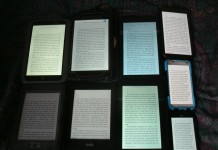 The more I talk to people about the uber index idea, the more I realize the significant effort required to create and implement it, particularly in the e-reader app. I still believe it’s a viable solution for rich content, but maybe it’s not something we’ll see in the short term. So how about a few simple thing between now and then?
The more I talk to people about the uber index idea, the more I realize the significant effort required to create and implement it, particularly in the e-reader app. I still believe it’s a viable solution for rich content, but maybe it’s not something we’ll see in the short term. So how about a few simple thing between now and then?
Let’s start with a “back” button in the e-reader, to take you back to where you just came from. Every time I’ve clicked on a link in an ebook and it takes me to an earlier/later spot, there’s no easy way to go back. Or how about when you’re in the index and you click on an entry, hop to it but it’s not what you were looking for? You’re stuck on that page and you have to manually find your spot back in the index again. Imagine a web browser without a back button. Pretty awful, right? So why do we have to live with e-readers without back buttons?
How about pop-up windows? Why are all the popular reading apps typically built with just a single window in mind? Imagine how frustrated and less efficient your day would be if your computer only let you open one window! In the index, if I press and hold an entry, show me a preview of where I’ll be taken if I make that selection. It’s the same concept I use all the time in my Bing search results, so that I can preview where I’m heading before I leave the current page.
And how about similar functionality in the body of the book? Press and hold a word or phrase and you get a list of related entries and “see also’s” from the index. For example, let’s say I’m reading the “Get Online” chapter of iPad: The Missing Manual and I see the term “3G”. If I press and hold it in my iPad ebook reader there should be a list of links to where 3G is first defined in the book. But there should also be links to where related topics are covered, such as AT&T, cellular network and even wifi, so that I can understand the difference.
Next, similar to pop-ups, why not let me have a split view into the book, or, heaven forbid, allow me to have two books open at the same time, both visible on the screen, one using the top half and the other using the bottom; these are basic features we take for granted in apps like Word or Excel but they’re nonexistent in the ebook app world.
The index is such a critical element of a print book and it could take on so much more functionality in ebooks. Which reader app will be the first to enable these types of enhancements? I’m not particularly loyal to any one of them, so I just hope at least one of them offers these features sooner rather than later.
Editor’s Note: the above is reprinted, with permission, from Joe Wikert’s Publishing 2020 Blog. PB


































Uh, *which* ebook reader are we talking about?
“Let’s start with a “back” button in the e-reader, to take you back to where you just came from. Every time I’ve clicked on a link in an ebook and it takes me to an earlier/later spot, there’s no easy way to go back.”
Cause *my* ebook reader *device* (the PB360) supports back just fine for hyperlinks (you even get to choose which button to use) and so do the Hanlins. Not sure about Bookeens but I vaguely remember somebody saying they also support hyperlinks properly.
And, as for a labeled dedicated “back” button, Kindles have one.
So, please, what device(s) are we wishing were designed differently, here?
That said, I’ve noticed a tendency for some people to think ebook readers should be webpads, PDAs, even computers. Which, to me, defeats the whole point of a device *optimized* for long-form reading. Content consumption not content generation.
An ebook reader should be first and foremost about reading electronic books. Anything else that they might offer is a value-add bonus as long as it doesn’t detract from the core experience. Cause right now I’m hearing of a *lot* of products cluttering the marketplace with “sporks” and “swiss-army knife-wannabes” that pretend to be ebook readers but are functionally useless as such.
Might be time to start reminding people that just because it says it’s an ebook reader doesn’t mean it’s really an ebook reader. 😉
[quote]Press and hold a word or phrase and you get a list of related entries and “see also’s” from the index. If I press and hold it in my iPad ebook reader there should be a list of links to where 3G is first defined in the book.[/quote]
Unless you can come up with a way of making this information part of the book, I don’t see how this can be done.
[quote]But there should also be links to where related topics are covered, such as AT&T, cellular network and even wifi, so that I can understand the difference.[/quote]
Again, probably not possible.
A programmers first question would be. “How (and where) do you define ‘related topics’?????”.
And unless you can come up with a way of storing that information in the book it’s not going to happen.
And on a sidenote. Back works just fine on my Bookeen GEN3.
Felix, sorry…I should have been more specific. I abandoned my Kindle when I bought an iPad and it’s the iBook reader I’m referring to. There’s no back button functionality built in but I’m hoping Apple will add it before too long. And although I’d like my e-reader app to do more than it currently can I’d like to think the other features I’m asking for (e.g., open to two different places in the book) aren’t asking all that much.
Jotunbane, regarding your point about not seeing how it can be done… It could be, but the reader apps have to add this functionality.
@Joe Wikert: So your point is about the iPad, not a dedicated reader. Fair *and* appropriate. Since the iPad is a pricey general-purpose “app-appliance” rather than an optimized reader device asking for more usability/value is perfectly appropriate. Knowing the baseline kinda helps.;)
😉
the reader apps have to add this functionality.
And being a programmer I can tell you, thats not going to happen.
It requires the existence of a “General purpose topic relation database”. And unless you can show otherwise, such bases don’t exist.
An alternative could be something like a google or Wikipedia search, but I dont think that is what you are gunning at here.
You are using terms like “related terms” and “related topics”, but where is this relation coming from? And if your answer is “From the app”, you have a problem. Remember… Computers can’t read.
Felix: you appear to be defining an ereader as a device for reading simple fiction. The functionality described in the post would however be very useful for non-fiction. Heck, in some instances it would be nice in fiction, too.
@Ric Day; I’m defining ebook readers as optimized for reading, not communication. (And *not* content-creation; PCs create content. Readers consume it.)
This makes standalone, unconnected features core.
I’m not advocating *simple* per-se; designers can get as fancy as they want as long as the thing doesn’t *require* a connection to work. “Related topics” is one example of a feature that is pretty much useless without a live connection to some cloud service and as such is secondary in my definition.
A reader device that requires a connection to deliver *core* functionality (like the Joo Joo) is a webpad or a terminal, not an ebook reader.
Consider that Kindles work beautifully without their wireless but iPhones and iPads lose most of their Raison d’etre *without* their wireless.
As to content creation; we’ll see how much it *really* matters with the ASUS eTablet and (earlier) with the PB302, which has USB host and bluetooth and is getting a Writer app to turn the eink device into a Word Processor. The platform already has games, apps, and a Browser so they’re turning it into a PC-like device. We’ll see how far that gets them.
Core features are *why* a product sells and as far as I know, what sells ebook readers is reading, not writing novels or surfing the web. And that reading tends to mirror customer reading habits; which is to say, mostly fiction and current affairs, with a niche of corporate academic use. Its not a matter of simplicity but of focus.
Products evolve and ebook readers are a young development. But products that lose their focus and evolve too far away from their core function become either niches or vanish.
@Felix Torres: “products that lose their focus and evolve too far away from their core function become either niches or vanish.”
I guess we are looking at this a little differently. A printed and bound book is limited by its container. If I am reading a printed book and want to know the meaning of a word, I must open another book to find the definition. I want an ebook reader to either contain a dictionary, or to link to one. I read in four languages, so linking to a dictionary might be a better approach.
When I read printed books, I often make notes in pencil in the margin – not when I am reading, say, Lee Child, but fiction authors like Umberto Eco and Douglas Hofstadter tend to provoke note taking. Almost everything published by O’Reilly does. So I want my ereader to allow me to take notes.
I do not think that any of the above would move ereaders away from their “core function.” I think such features are fundamental. I’m afraid that your apparently very narrow definition is akin to saying, let’s move the text from the printed page to the digital screen and stop there.
The history of solid-state electronics has been dominated by a fast pace of product evolution and I am sure we will see a lot of experimenting with features in ereaders over the next few years. Personally, I welcome devices with more than a single function — I do not much enjoy the need to lug around my laptop and smartphone and ereader (along with charging cables and bricks) and would much prefer a single device. I have no problem concentrating on one function at a time (telephone calling/reading/writing/programming); I just don’t care to have to deal with multiple devices.
We do live in interesting times!
@Ric Day; I was adressing the point about non-reading functions and connectivity.
Book-marking, highlighting, clipping and note-taking are clearly part of the reading experience. And pretty much all ebook reading apps since the last century support those. That is exactly what I mean about core features.
Writing essays, sketching, taking dictation isn’t.
(Though the eeeTablet seems headed that way.)
Embedding bar code readers isn’t.
(Though the Asus eReader goes that way with its upcoming Kindle-wannabe.)
Surfing online databases for even relevant data isn’t.
“Reading exerience” means ergonomics and controls, as this post wants to discuss, itmeans dictionaries and thesauri, and it means file management and user typographical controls. Right?
I thought I said as much between both my comments.
If I thought ebooks = electronic paper I’d be pimping PDF pretend-paper instead of pining for more optimized reader devices in the face of the current wave of intentionally sub-optimal general purpose of misabeled Tablets-as-ereaders.
I don’t think we’re arguing too different things; I just want a shar knife not a dull spork.
I believe the best reading experience (for heavy readers) will come from devices *optimized* for ebook reading, not general purpose devices.
To me this means actual mechanical switches properly positioned; it means extreme battery life; it means extremely low mass readers. It means always-on functionality (a result of the extreme battery life) and it means a very low cost; my money should be going to the books, not to a hardware manuacturer or bandwidth vendor. And it means that I want to see a device expressly designed for textbooks in the higher education market coexisting with things like Kindle or my PB360 paperback-sized reader.
I’m not advocating banning multipurposes devices, okay?
I just want to make sure *optimized* devices remain as viable options for those of us interested in books. And I really don’t want ebook readers turned into PDAs or webpads; those devices already exist in their own markets.
As an indexer, I have to say that comments like:
“A utility would run the book’s contents against the uber-index and generate all the relevant links.”
reveal a staggering ignorance of how indexes are crafted in the real world, and the human intellectual effort it takes to extract meaningful text from a book and place it in context.
Seriously, just run an ASCII eBook through a concordance program some time — there are several available on the web for free download — and see just how useless for finding information the resulting lexicon is. Text-based search works in a vague general way when there is lots of input and lots of more-or-less-acceptable results; it remains extremely poor at locating specific content in a limited corpus.